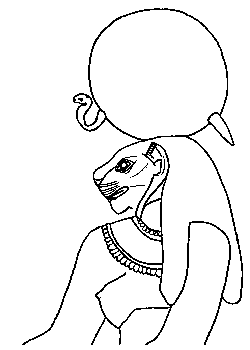
One of the most important Egyptian goddesses, who was worshipped from the Old Kingdom down to the Late Period. She is usually depicted as a woman with the head of a lioness and a closed mouth. In the New Kingdom she acquired the sun disk, uraeus, ankh-sign and papyrus sceptre as attributes. Iconographically, she is hard to differentiate from other goddesses with lion's heads. Her name means 'the powerful one' and refers to her wild and dangerous nature, which over the years became gradually more important.
There is very little evidence for a cult of Sakhmet in the Old Kingdom. Together with lion-headed Shesemtet, she already appears in the Pyramid texts in the role of mother-protectress of the king. Although there is no evidence for a link with Bastet in the Old Kingdom, the plentiful evidence from the Middle Kingdom and later suggest that this link did in fact exist earlier. During the Middle Kingdom, the protective qualities of Sakhmet fade into the background and she becomes increasingly a wild and dangerous goddess. Her friendly aspect is now represented by Bastet, with Sakhmet displaying the wild, destructive aspect of the lioness goddess.
These qualities enable her to help and protect the king in his fight against his enemies and she became a model for the correct attitude in battle. She had arrows and scorching breath to fight the enemy. These weapons also turned her into a fire-spewing goddess who brought sickness, thus linking her with illness and epidemics. Because Sakhmet was the cause of illnesses, she was also the one who could cure them. Thus the priests of Sakhmet had a special link with medicine and magic. The Sakhmet priest had to ward off disease-bearing demons with magic.
As a result of her fire-spewing aspect, Sakhmet was also associated with the uraeus; in the Coffin Texts she is linked with the Lower Egyptian uraeus Uto.
Because of her link with Uto, who was regarded as an Eye of Re, Sakhmet could also be seen as an Eye of Re and merged with all the other goddesses who appear as the Eye or daughter of Re.
In the Myth of the Heavenly Cow, Sakhmet appears as a bloodthirsty goddess who wants to destroy mankind on Re's orders but is prevented from doing so because Re, having changed his mind, calms the goddess by craftily giving her blood-coloured beer to drink. She is also assimilated with Tefnut in the stories about the sun's eye remaining abroad and having to be persuaded to return to Egypt.
Her links with other goddesses resulted in an expansion of her own characteristics; she could appear as a cow and was given epithets such as 'the large one' and 'mistress of the sky'. From the New Kingdom on, the favourite epithet was 'Sakhmet the Large One, beloved of Ptah'. Her most important cult site was Memphis, where she was worshipped as the consort of Ptah and mother of Nefertem from the New Kingdom on. We also know of a cult of 'Sakhmet of Sahure' from the New Kingdom that lasted until well into the Greek period. This cult was celebrated in the southern part of the mortuary temple of Sahure around a statue or relief that probably originally depicted Bastet, and was particularly popular in the 18th Dynasty. Sakhmet was also worshipped in almost all the great temples.
In the New Kingdom, Sakhmet regained her role as a mother. In the New Kingdom we also hear for the first time of a connection between Sakhmet and Mut, probably because Thebes had become the capital and the people wanted to link the new and the old residences with each other. As a result, Sakhmet was completely merged with Mut.
In the Late Period the emphasis was once more on her destructive side, and Sakhmet characteristically appears in magical texts; we meet her in particular as the destroyer of enemies, but also as the one who must be calmed with special rituals.